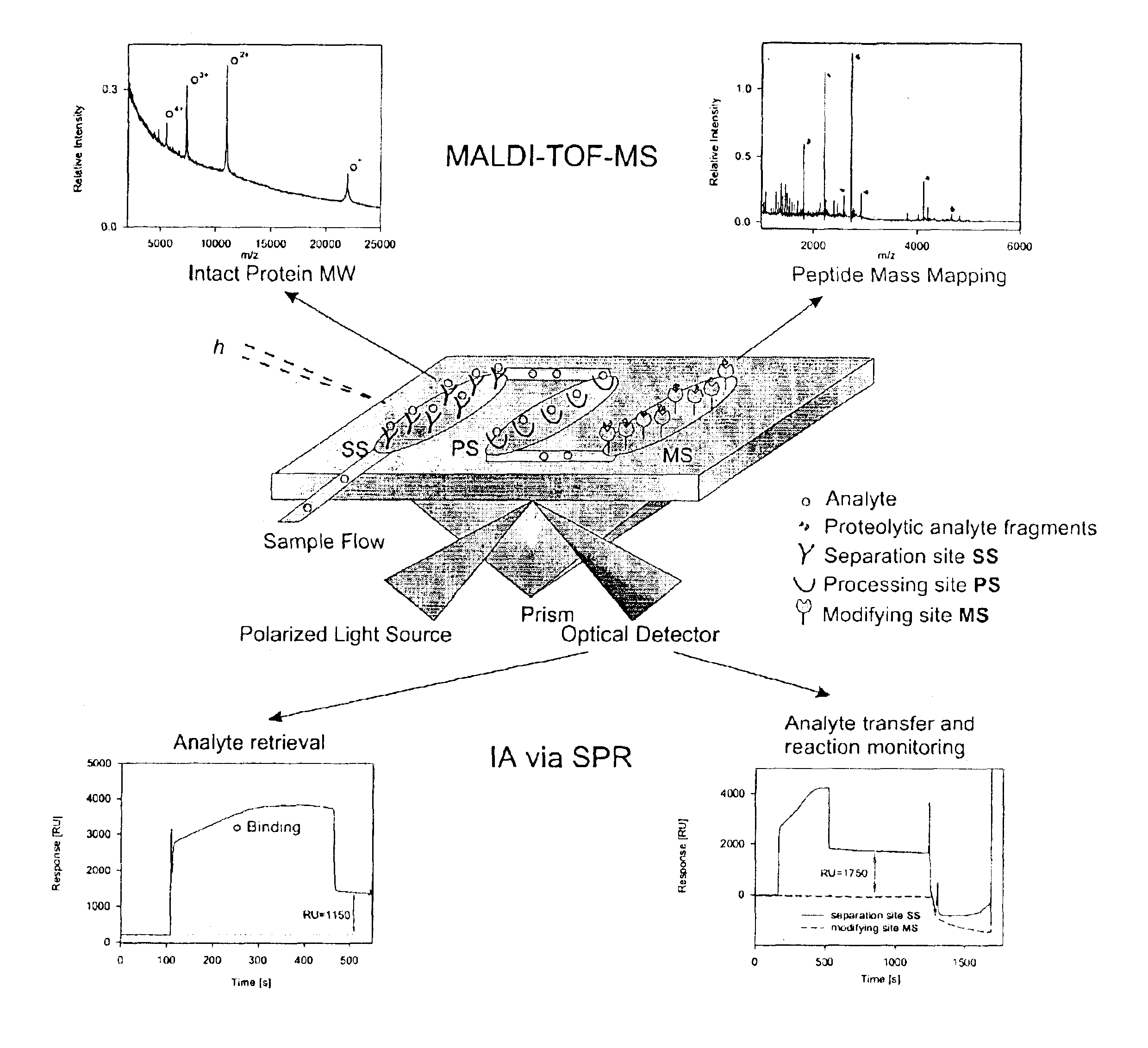Bioactive chip mass spectrometry
a bioactive chip and mass spectrometry technology, applied in the field of bioactive chip mass spectrometry, can solve the problems of limited application, intrinsic complexity of studies, and limit the extent of practical application, and achieve the effects of identification and/or quantification, capture and subsequent digestion or derivatization
- Summary
- Abstract
- Description
- Claims
- Application Information
AI Technical Summary
Benefits of technology
Problems solved by technology
Method used
Image
Examples
example 1
Separation Site SS
[0079]In this example, capture of IL-1α on a separation site SS and subsequent MALDI-TOF mass spectrometry performed directly from the separation site SS on a bioactive chip BC is shown. FIG. 2a shows a sensorgram of anti-IL-1α antibody immobilization on the separation site SS. The response change of 6900 RU indicates the immobilization of 6.9 nanograms of material, which corresponds to ˜46 fmoles of antibody (MWIgG˜150,000) immobilized (maximum valence ˜92 fmole). FIG. 2b shows a sensorgram of the subsequent capture of IL-1α (10−4 mg / mL, in large excess (10 mg / mL) of human serum albumin, HSA). A response change of 1150 RU indicates the retention of ˜1.15 nanograms of proteinaceous material (˜60 fmole of IL-1α). FIG. 2c shows a MALDI-TOF mass spectrum taken from the surface of this separation site SS. The observed m / z values of 18038 Da, 9021.7 Da, and 6017.2 Da correspond to the singly, doubly and triply charged ions of IL-1α and are in good agreement with the cal...
example 2
Separation Site SS: Optimization of the Flow Rate
[0080]In an example of separation site SS optimization, mouse monoclonal anti-human interluken-1 alpha (anti-IL-1α) was immobilized on a separation site SS on a bioactive chip BC using an amine-coupling procedure (as shown in the previous example). 100-μL aliquots of solutions containing human interleukin-1α (IL-1α) were injected over the separation site SS at various flow rates. A low analyte concentration (10−5 mg / mL IL-1α, with and without 10 mg / mL human serum albumin (HSA, carrier protein) in HBS) was used in this example to avoid saturation of the immobilized anti-IL-1α (SPR response at saturation; ΔRU=1600). The binding curves shown in FIG. 3 (inset) show increased binding at decreased flow rates, indicating that the efficiency of retrieval increases geometrically as the flow rate is decreased. At the lowest flow rate examined (1 μL / min), ˜31 fmoles of IL-1α were captured, equating to a capture efficiency of approximately 56% (5...
example 3
Separation Site SS: Competitive / Heterogeneous Systems
[0082]This example shows the applicability of BCMS in analyzing competitive / heterogeneous analyte systems. FIG. 4a shows a sensorgram of the interaction between streptavidin (immobilized on the surface of separation site SS on a bioactive chip BC) and the recognition sequence—HPQ—contained in the peptides:
[0083]SGTSFHPQWIMVGKVATNSP (SEQ ID NO: 1) (Pep K; MW=2203.5 Da), and.
[0084]SGTSFHPQWIMVGRVATNSP (SEQ ID NO: 2) (Pep R; MW=2231.5 Da).
[0085]A bioactive chip BC containing streptavidin-derivatized separation site SS was exposed for 60 s (at a flow rate of 20 μl / min) to a mixture containing 10.0 μM Pep K and 10.0 μM Pep R, after which a ˜15 s exposure to the running buffer followed. The separation site SS on the bioactive chip BC was then MALDI-TOF MS analyzed. FIG. 4b shows an overlay of two mass spectra resulting from the analysis of the peptide mixture before (MALDI-TOF MS of the analytical solution, grey) and after the interacti...
PUM
| Property | Measurement | Unit |
|---|---|---|
| pH | aaaaa | aaaaa |
| mass shift | aaaaa | aaaaa |
| pH | aaaaa | aaaaa |
Abstract
Description
Claims
Application Information
 Login to View More
Login to View More - R&D
- Intellectual Property
- Life Sciences
- Materials
- Tech Scout
- Unparalleled Data Quality
- Higher Quality Content
- 60% Fewer Hallucinations
Browse by: Latest US Patents, China's latest patents, Technical Efficacy Thesaurus, Application Domain, Technology Topic, Popular Technical Reports.
© 2025 PatSnap. All rights reserved.Legal|Privacy policy|Modern Slavery Act Transparency Statement|Sitemap|About US| Contact US: help@patsnap.com



